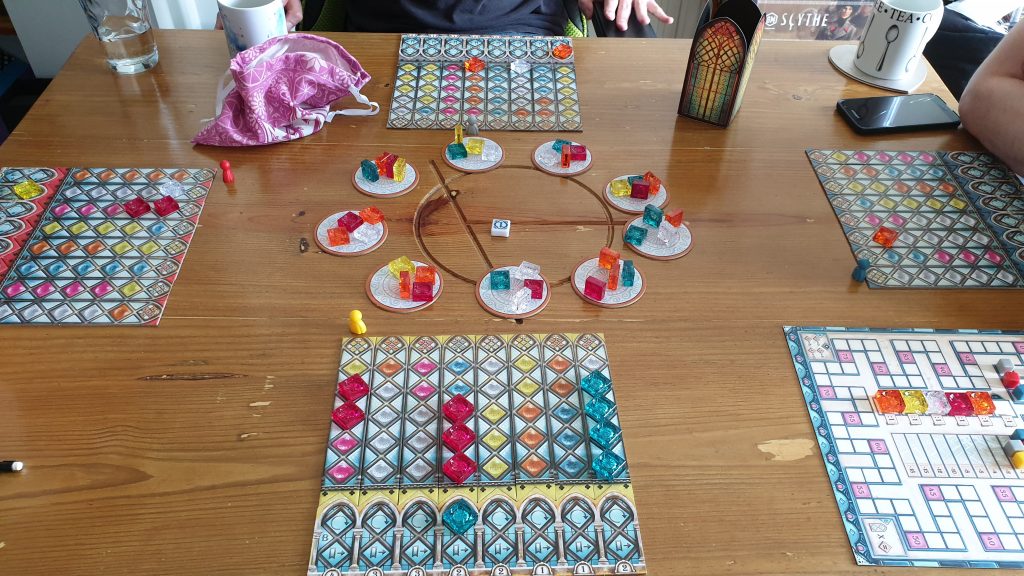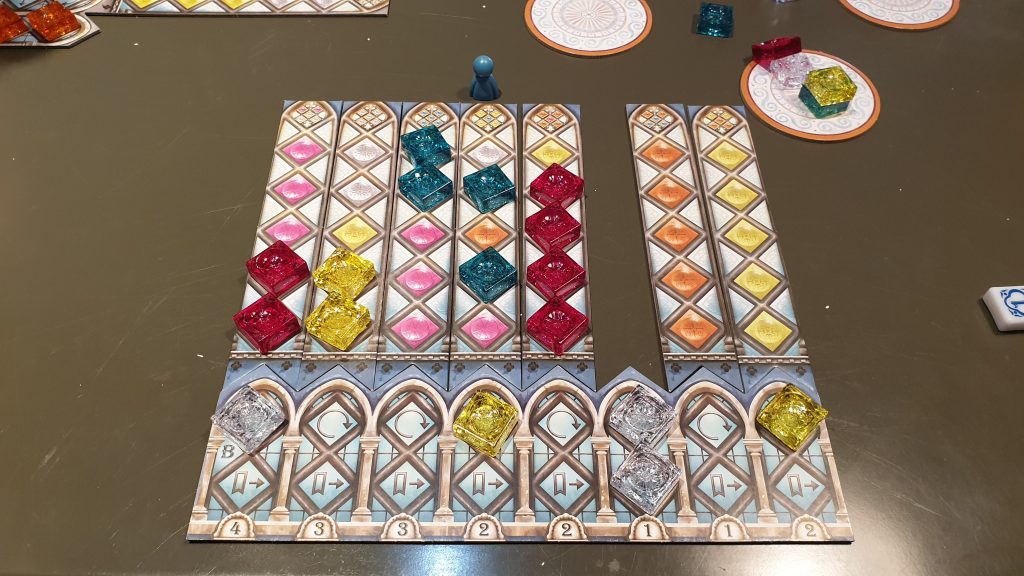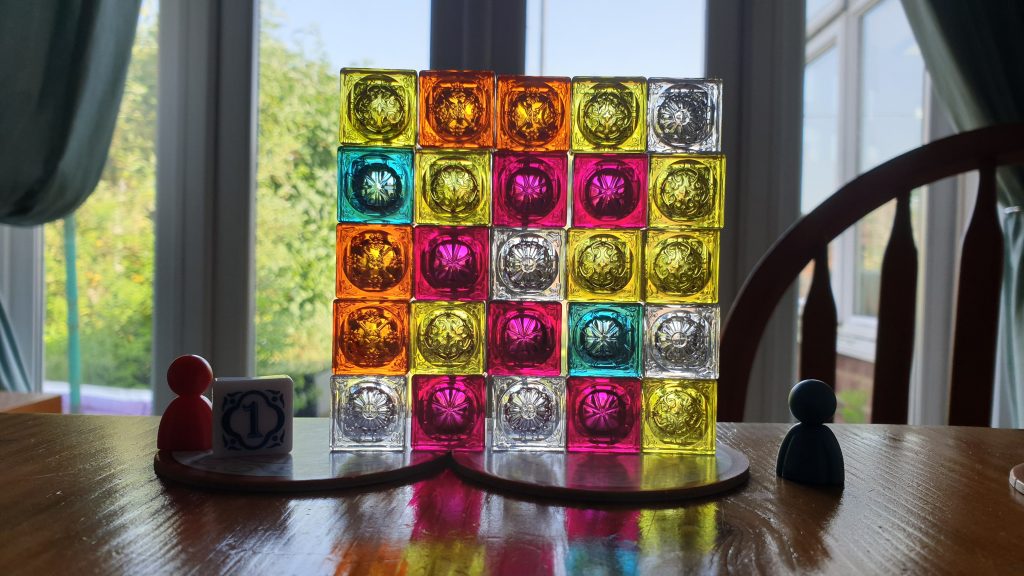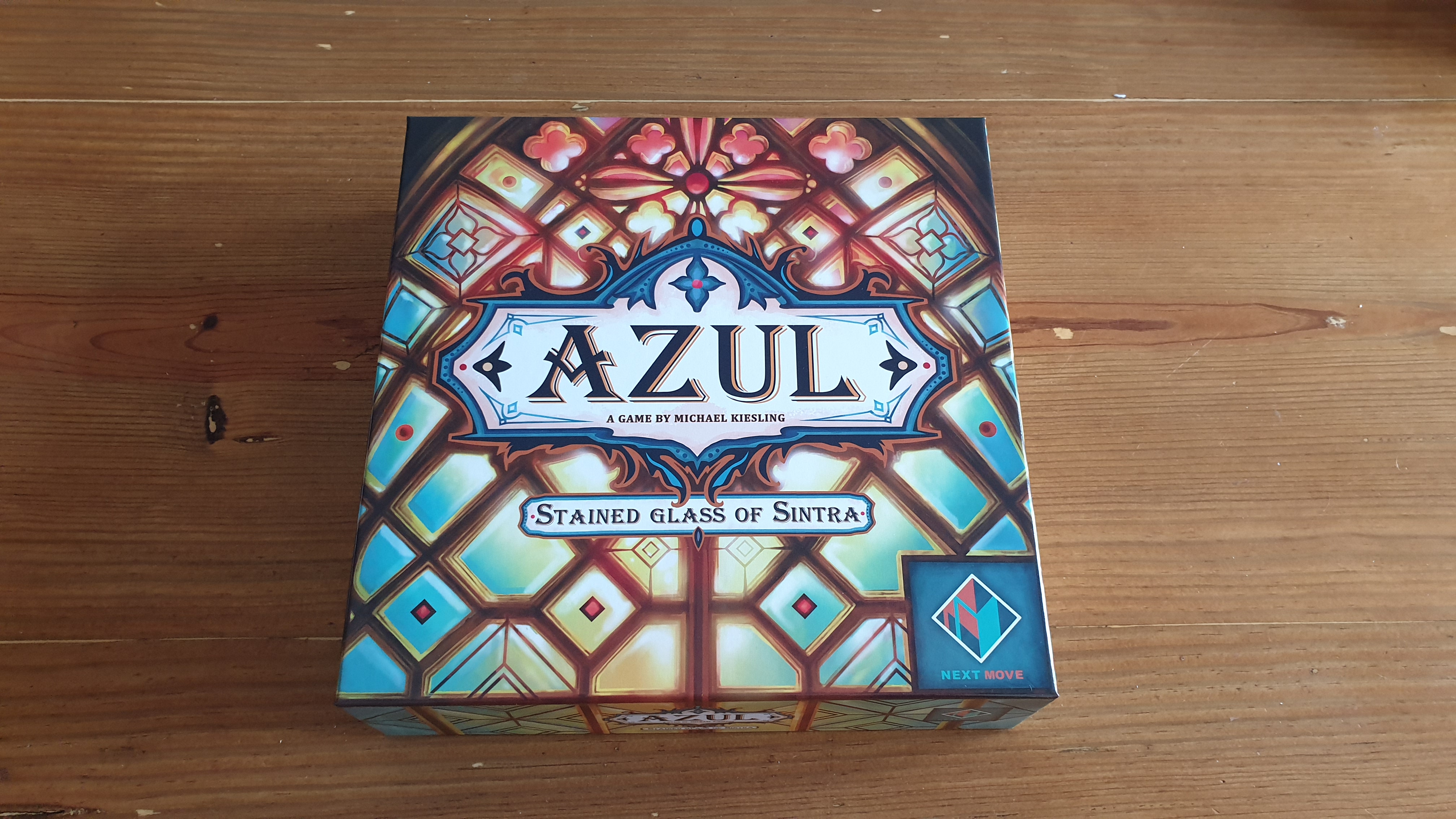Azul released two years ago and took the board gaming hobby by storm. The sequel, Azul Stained Glass of Sintra, has recently been released by Next Move Games. Designed by Michael Kiesling, with art from Chris Quilliams, this time around 2 – 4 players will be constructing windows with colourful glass panes. Taking around 30 – 40 minutes to play, the tile placement mechanics have been shaken up somewhat. However, is there enough of a change to warrant owning both this and the original? Let’s find out!
At the offset of the game each player takes a board and aligns up their window sections in any order. Players place their worker above the left most window, this being the first noticeable shakeup from the original Azul. Then, 6 glass tiles are randomly drawn from the panes bag and added to the scoring board. These are round markers and bonus colours for the associated rounds, the second change from the original. Based on the player count a number of factory tiles are put into the center of the table and upon putting player cubes at zero on the broken glass and score tracks the game is ready to be played.
At the start of each round the starting player draws four window pane tiles for each factory. The starting player token is placed in the centre of the factories and the round begins. On a turn a player can choose to either take tiles or if their worker isn’t in the left most column rest. Taking tiles works the same as in Azul, with players having to take all of one colour from either a factory or the middle. Taking from a factory sees the rest of the pane tiles, of other colours, discarded into the middle. Taking from the middle still sees all of one colour taken but no additional discard action is made. If you are the first to take form the middle you gain the first player marker for the next round but also move one step down the broken glass tracker.

Once you have taken tiles you must instantly choose where to put them. Each window section has colours of glass panes it requires to be finished. Choosing a single window section to the left or below your worker, you must move your worker there and fill in the coloured window sections possible with the tiles taken. Any left over are discarded into the glass tower pot and you move down the broken glass tracker than many spaces. If you have filled in all five tile spaces on a window it instantly scores, otherwise play moves onto the next player.
The first time a window is completed four of the tiles on it are added to the glass tower and it is flipped over, being removed the second time around. The fifth tile, which is chosen by the player, slides down onto their player board for end game scoring. The window then scores based upon the number below it on the player board plus the points earnt by any previously completed windows to the right. Note when calculating these points to the right each is only awarded once for each column whether a window is completed once or twice. Bonus points are then awarded per tile of the rounds special colour.
If on a turn you do not want to take any available tiles, or the windows you want to build on are to the left of your worker you can rest. Instead of taking any tiles you simple move your worker back to the left most window. Play continues until all tiles are taken. At this point the round’s bonus colour tile is removed from the scoreboard, being added into the glass tower. If the end of the game isn’t reached the next round starts with whomever gained the first player tile and it is back up to the top – dishing tiles out from the bag onto the factory tiles. If the bag runs out at that point simply tip the glass tower into the draw bag and continue. While not explicitly stated in the rules if it is not possible to fill each factory just fill as many as possible. This isn’t common but it did occur in one 4 player game where everyone was building up every window panel.

When the final round has ended there is some bonus scoring and negative points to be determined before the winner can be crowned. Firstly, for every set of 3 tiles still on your windows you gain a point. Secondly, you multiply the number of fully completed (removed) windows with the number of tiles of a single colour you have on your player board of completed windows. Say you have three fully completed windows and via completed windows three yellow tiles and two purple tiles. This would be 3 windows multiplied by 3 (yellow being highest) to gain 9 bonus points. Finally, subtract from your score the indicated amount of the broken glass tracker and whomever has the most points wins!
In a similar way to the original, the amount of points lost increases at a faster rate than one for one, the higher up the broken glass track you go. Unlike the original Azul these aren’t deducted at the end of each round, making the points lost build up over time, up to -18 points. If, and it is rare, a player reaches the -18 points mark this is instantly lost. Plus, they start the tracker again from zero. This adds a bit extra to individual player decisions. While for one player taking from the middle first may be a -1 shift, for another further along the broken glass tracker it could be a -3 or more shift. Therefore, it can be more detrimental for others to draw from the middle so you can try to force them into it or take suboptimal moves.
There has been a bit of a mixed response to the inclusion of the ability to rest – effectively passing. Some have seen this as an unwanted addition, which can add a little analysis paralysis via more options on a turn. Whilst this is somewhat true it gives choices more meaning, as on future turns you can only build to the right, before resetting. This makes it extremely beneficial to reset just before the next round. Though what if there are tiles you want to take too? It gives a balancing act to manage and something to time – perfect for some but not everyone.

The end game scoring isn’t overly complicated but it isn’t obvious either. While it is intuitive that the number of fully window finished is beneficial, it is the multiplication that new players seemingly forget or confuse. Some kind of symbology or mentioning of the scoring on the player boards may have eased this problem, serving somewhat as a reminder throughout. Despite this the end game scoring works well at giving players something to work towards. It might take a game to understand but it is worthwhile learning.
Component wise Azul Stained Glass of Sintra is close to being a better title than the original. The glorious translucent glass tiles have been universally enjoyed more than the not-all-patterned tiles from Azul. The scoring trackers and cardboard factory tiles are just as good and the design of the windows and personal player boards works well, though can be a little fiddly for some when being flipped. Alas, two elements stand out as weak points. A lot of tiles are going to be thrown into and tipped out of the glass tower yet it feels like it is made of thick paper, being certainly on the flimsy side. The second issue is more the oddity of the decision to not have a theme matching first player token. This is an extremely small thing but it looks odd on the table, as if you’d lost the one included and pillaged the original Azul’s box.
The big question of if Azul Stained Glass of Sintra is better than the original is a tough one to answer for everyone at once. The additional decisions driven by tweaks to losing points, the end game scoring and the inclusion of passing makes it more of a “gamer’s game”. Due to this the instant unbox and play factor the original excelled at, that simplicity of just take and use, is lost. Both are phenomenal abstract puzzles but with extremely similar mechanics. Due to this is isn’t possible to recommend owning both – neither being a killer of the other. Owning one or the other would hold a good spot in any collection. If you enjoyed the original or you are new to the world of Azul, Stained Glass of Sintra should very much be on your “to play” list though!
[Editor’s Note: Azul Stained Glass of Sintra was provided to us by Asmodee for review purposes. The game is currently available on 365 Games for £38.99. It is also available from local UK board game stores, find your local store here.]

